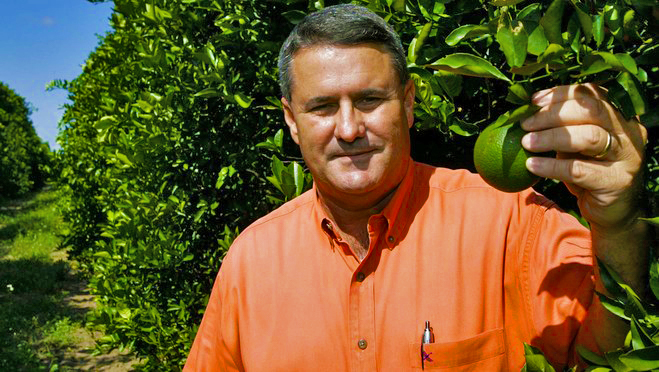Despite Greening, Citrus is still King in Highlands County
by RACHEL CHRISTIAN
Highlands County has a population of roughly 105,000 people. It’s also home to about 110,000 cattle and 8.5 million orange trees.
“I always say we have more cows than people here – and a heck of a lot more oranges than either of those,” says Ray Royce, executive director of the Highlands County Citrus Growers Association.
Farmers in Highlands County wrapped up the citrus season in early June this year, and although official numbers won’t be out until August, Royce says his organization anticipates a 5 percent yield increase over last year’s harvest of just under 8 million crates.
That’s promising for an industry still shaken by citrus greening disease, the devastating botanical ailment Florida scientists and farmers have been battling for more than a decade. Hurricane Irma dealt another blow as farmers dug out from damage during the 2017-2018 season, resulting in a statewide 37 percent production drop over the previous season.
Yet, Highlands County remains one of the top three biggest citrus producers in Florida, and although numbers might not return to where they were 15 years ago, Royce is pleased at the modest gains made this year.
He attributes it to progressive, hands-on farmers who adapt quickly in what he calls “the greening era.”
“You have to be all-in,” he says. “You have to develop and execute a good plan. You can’t just sit back and say, ‘This is how my grandfather did it’ and expect to get good results.”
Citrus growing is more hands-on than ever. Weekly and sometimes daily monitoring of soil samples and leaf tissue are necessary to determine what’s working in the field and what’s not. It can be a lot of trial and error, Royce said, and part of that is due to the unpredictable nature of greening disease. There’s no one-size-fits-all solution, though certain techniques are proving promising.
One major shift in Highlands County is the size and number of orange trees. Root zones are smaller than they used to be, so trees need to be trimmed and cropped to prevent them from toppling.
It’s resulted in denser groves with more, smaller trees closer together. Where once there were 70 trees per acre over 30 years ago, growers are now planting 200 to 300 trees per acre.
“You’re not expected to have as big of a tree, and you don’t want that anyway because there’s not going to be a root system there to support it,” Royce explains.
Growers are also experimenting with slow release fertilizers and foliar feeding – a technique of providing nutrients to plants by applying liquid fertilizer directly to their leaves.
Other variables like irrigation schedules are tweaked frequently as well as pesticide and bactericide treatments.
The end goal is to reduce outside stress on each tree, Royce said, so that it yields healthier fruit for longer.
“Growers are listening to what the trees are telling them,” he says. “They have to spoon feed them nowadays.”
Farmers are working closely with one another, trading tips and sharing advice, but they’re also partnering with scientists from the University of Florida IFAS extension office to stay current on emerging information and best practices.
Some recent research from UF includes gene therapy of greening-resistant citrus strains and an automated robotic arm system that can puncture tiny holes into a tree trunk and directly inject bactericide.
Remaining vigilant about greening will be essential moving forward, Royce said, but so too will staying alert to other possible threats.
On June 14, for example, the UF/IFAS office issued a pest alert after finding lebbeck mealybugs in Highlands County.
It was the first find of the pest in a commercial citrus grove, and researchers are already setting up field trials to test different approaches that can manage mealybugs under real world Florida growing conditions.
In the meantime, Royce explains that growers are finding their own ways to mitigate the pest, including introducing beneficial predatory insects like ladybugs to the trees.
“You never know what could come next,” he warns. “We have to keep our eyes open and be very adaptable.”
Agriculture still reigns supreme in Highlands County, an area of about 1,100 square miles south of Polk County. Land has been insulated from some of the commercial development intruding on agriculture property along the coast and around Orlando. A third of all jobs in Highlands County are agricultural.
There’s 60,000 acres of citrus in Highlands, and the county produces about 13 percent of North America’s orange juice.
Royce and others in the Highlands County citrus industry are optimistic about its future. Five percent gains each year would be a welcome sight.
“Where there are challenges, there are opportunities,” Royce says. “We’re seeing entirely new blocks of groves going in now, and for me, that’s very promising.”
With roughly 80 times more oranges than people, it’s clear citrus is still king in Highlands.

